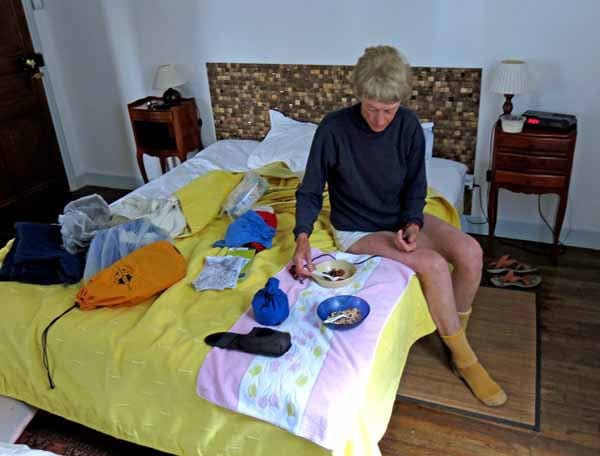
Tuesday, 1 July 2014
Distance 21 km
Duration 4 hours 55 minutes
Ascent 330 m, descent 373 m
Map 147 of the TOP100 lime-green series
Asleep between fine sheets, I was pinched and punched without warning by my calendar-conscious lover, and the day began.
Mixing up powdered milk for muesli in a plastic bowl seemed at odds with our elegant surroundings, but we had decided that the hotel breakfast at eight o’clock was too late, and we were out in the street by 7:30 am.

We went up the roughly-tarred lane to the main square, where the bar was as dead as expected, and wandered through the streets on our way to the intersection that we had arrived at yesterday from the valley.
We were looking for a small turn-off at the intersection, and we soon found one.
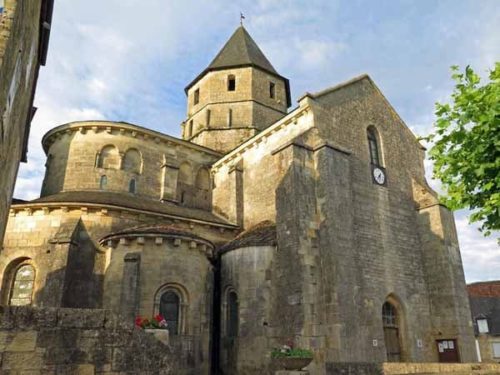
Unfortunately it was the wrong one, as we discovered after ten minutes of steep descent parallel to the main road.
Back at the intersection, and not very pleased with ourselves, we finally found the right road, which turned off slightly further back. We had walked straight past it the first time without noticing it.
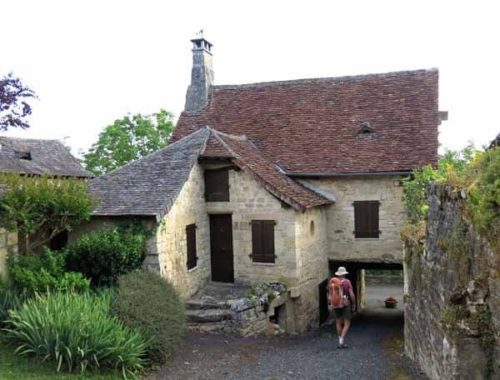
This little road drifted along through the fields below the village and after a couple of kilometres we passed the entrance to a place with holiday cabins in the valley below. (Earlier we had hoped we could camp there, until we found that the restaurant was not functioning.)

The road soon degenerated into a wheel track which went down abruptly through a forest and became bitumen again as it emerged.
Coming up this road towards us we saw a figure from the eighteenth century, hobbling on a stick and swathed in a long black coat, scarf, leggings and a close-fitting cap.
It turned out to be an old woman, who looked at our bare legs and arms in disbelief and said “Well, you must surely feel warmer than me!”.

At an intersection the road turned towards Segonzac, and we passed a new-looking sign pointing to the railway station, which was odd, as the line had been closed long ago. Even the rails had vanished, or at least we saw no trace of them on our descent through the forest.
The village of Segonzac looked back to St-Robert on the hill opposite. It had a handsome church, some fine sturdy houses and not much else.

We took the D114 to the north, following a low ridge through pasture land and a few hamlets. A herd of brown cows strolled past us at one stage, but that was the only traffic we encountered until the crossroads at les Graves Blanches.
As we approached the intersection we saw a large white building that looked a possibility as a bar, but it was only a house. We had been walking for more than three hours and I was starting to flag, but we pressed on, taking the small fork to les Bichets.
By this time the meadows had given way to vast apple orchards, veiled in bridal white. French birds seem much fonder of apples than they are of cherries, which are often left on the trees unprotected and unmolested. The other industry of the area was logging, judging by the timber yards and piles of logs that we passed, although there were no forests to be seen nearby.
The older cottages of les Bichets were of mortared river stones, with the traditional flared roofline of the region, a charming style.

At the top of the rise, marked by a château d’eau (water storage tower), the land opened out below us and we looked down onto what seemed a shining lake, but was actually the white nets of apple orchards.
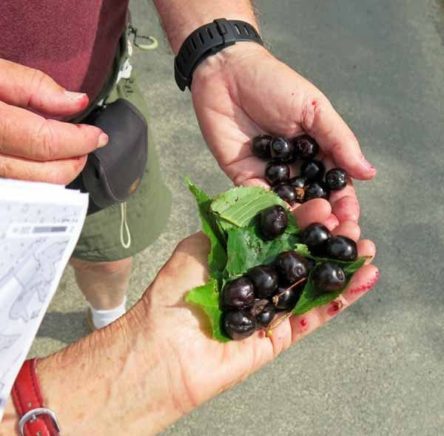
We crossed the D5E3, which formed the border between Corrèze and Dordogne although there was no sign to say so, and after a while we came to a cherry tree beside the road, laden with glossy black fruit, of which we ate as many as we could. They were lovely, but a poor substitute for coffee and croissants.
After half an hour among grassy fields, clumps of trees and the occasional orchard, the road started to descend to a stream, and we had to go around three sides of a large hedged orchard to get to the bridge.
We were tempted to take a short cut through the rows of apple trees but decided to be law-abiding, mainly because we feared that our way would be blocked by the hedge at the other end – a fear that proved to be unfounded.
As the road swung away from the orchard towards the bridge, we entered a patch of forest and never saw apple trees again that day.

Once over the stream, the road climbed out of the forest into the hamlet of Fargeas, where piles of logs stood waiting to be carted away.
We then kept climbing through pastureland to the top of the rise. It was hot, tiring, tedious work, so we were grateful when the road dipped into a thick forest and looped its way down to a small iron bridge at the bottom.
On the way up the other side I stopped in the middle of the road and declared dramatically that I could not go on, but I had no choice and anyway it was only a short distance to the D80, where we saw the sign for the camping ground (le Moulin du Chatain) pointing down a lane.
The sight gave us new energy and we quickly descended past the terraces and arrived at the entrance.
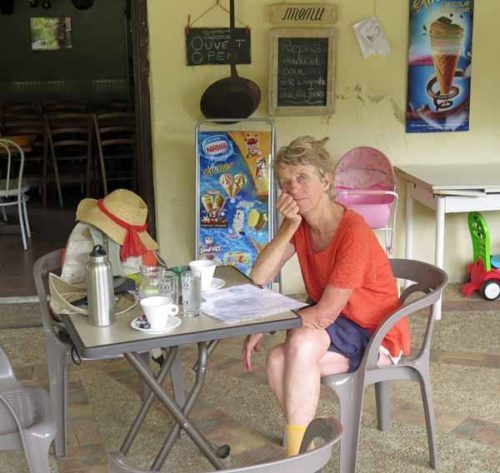
Attached to the reception building was a wooden annexe covered by a roof like a spread fan, evidently a bar or restaurant. A woman emerged from the back and took our €11 camping fee, then made us coffee, the first for the day and utterly delicious.
While we were luxuriating in this pleasure, people started arriving by car for lunch (it was now 12:30 pm), probably from the village of Paysac, about four kilometres away. We decided to do likewise, not because we were particularly hungry, but because we felt like being looked after.
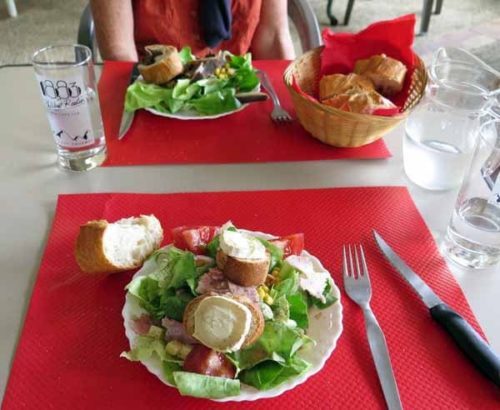
The menu was simple – salads, grilled meats and omelettes. As we intended to eat there again in the evening, we confined ourselves to salads for lunch.
Keith had his favourite Salade au Chèvre Chaud, with small goat’s cheeses on toast, and I had a Salade Périgordienne, piled with warm duck’s gizzards (not as gruesome as it sounds). With them we ate a mountain of bread and drank several jugfuls of cold water.

The waitress, daughter of the woman in charge, told us that the family were from Calais and had bought the place only a few months earlier, for the climate and the country lifestyle. This explained the notice on the wall – “Place des Ch’tis”.
Apart from the camping ground, it had pools where people could fish, and little walks among the ponds where diners could stroll after their meal.
The camping terraces were over a footbridge and were thinly populated with caravans and a few tents.
We were astonished at the grandeur of the shower block – each cubicle was the size of a bedroom, with the latest in shiny plumbing. However we had to wait half an hour for the water to warm up after Madame switched it on.
As we had been walking for a couple of weeks, it was time to wash our evening shirts, so we had to wear our walking shirts again, stiff with dried sweat.
By late afternoon the air was getting cold, and some light rain fell. Rugged up in socks and warm tops, we went down to the bar and had more coffee, exercising our brains meanwhile with a very hard crossword. Once again the terrace filled up with diners who arrived by car, but for us it was too cold so we went inside for apéritifs.
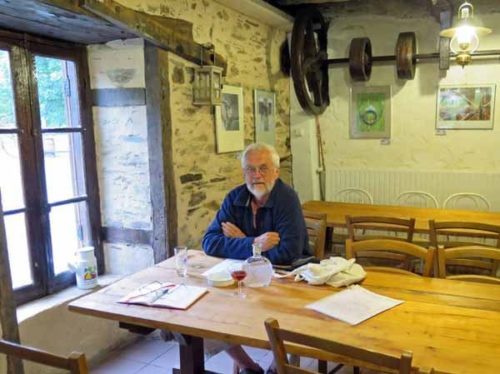
The inner room had massively thick walls, dark beams and a collection of old farm machinery strung up around the walls.
It was lovely to look at and much warmer than outside. Soon after we moved, our example was followed by all the other diners, and it became quite cosy indoors.
We began by sharing a Salade Ch’ti, loaded with ham, and followed that with steaks.
The chef came out to warn us that the steak was very thick and would be red inside, to which we replied that we liked it rare – or “saignant” (bleeding), as the French so delightfully put it.

They were as he described – plump and succulent, but more than I could eat. I had remembered to ask for something other than chips, and got pommes sarladaises – buttery, herby golden discs of potato.
Our stomachs had definitely shrunk since we started walking, and a good deal of this fine food made its way discreetly to the plastic container in my bag. However, we had no such difficulty finishing the wine.
When we asked the chef for the latest results in the World Cup, the conversation in the room became general, with other diners enthusiastically pulling out their iPhones to give us the scores and the predictions – all very convivial.
It was another story back at the camping terraces, where we seemed to be the last living creatures on earth, as the caravans around us were all unoccupied. But we were snug inside the tent, especially when it began to rain, and we slept the dreamless sleep of the long-distance walker.
Previous section: Souillac to St-Robert